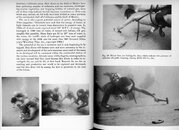David Wilson
Contributor
Right, time to move on to masks made in a country that was a constituent republic of the USSR but is now an independent nation state: Ukraine. Bordering the Soviet Union's equivalent of the Mediterranean, the Black Sea, Ukraine was a logical place to set up factories servicing the water sports market, including breathhold and scuba diving. The name of the Ukrainian plant responsible for the production of basic diving gear, including fins, masks and snorkels, in the 1960s and 1970s was "Красный резинщик" (Transliteration: "Krasny Rezinshchik". Translation: "Red Rubber Worker") and it operated in the capital city, Kiev. Here is a picture of the factory entrance:

The first Soviet mask made in Ukraine is only known by its factory name: Krasny Rezinshchik.
Krasny Rezinshchik



The third image shows the marking with the name of the factory and the city and country of origin, namely Kiev and the USSR.
Here is an English translation of the mask's entry in a Soviet diving mask table:
 And here is a pargraph I found about this model:
And here is a pargraph I found about this model:
Полумаска киевского завода «Красный резинщик» имеет силикатное смотровое стекло формы закругленного на вершинах треугольника, обеспечивающего хорошее поле обзора. Стекло крепится в сравнительно жестком резиновом корпусе металлическим ободком. Полумаска обеспечивает хорошую герметичность и удобна для плавания и ныряния. Некоторым недостатком полумаски является излишняя жесткость фланца, прилегающего к лицу.
Rough translation: The semi face mask from the Kiev ‘Krasnyi Rezinschik’ plant has a silicate-glass, rounded triangular shaped lens, providing a good field of vision. A relatively hard metal rim attaches the lens to the rubber body. The semi face mask provides a good seal and it is suitable for swimming and diving. A drawback of the semi face mask is the excessive hardness of the skirt adjacent to the face.
This triangular mask did not survive the Soviet era. It was quite popular, however, in the late 1960s. The second mask I will showcase is the the vintage version of the Akvanavt mask now made by Kievguma.
The first Soviet mask made in Ukraine is only known by its factory name: Krasny Rezinshchik.
Krasny Rezinshchik
The third image shows the marking with the name of the factory and the city and country of origin, namely Kiev and the USSR.
Here is an English translation of the mask's entry in a Soviet diving mask table:
Полумаска киевского завода «Красный резинщик» имеет силикатное смотровое стекло формы закругленного на вершинах треугольника, обеспечивающего хорошее поле обзора. Стекло крепится в сравнительно жестком резиновом корпусе металлическим ободком. Полумаска обеспечивает хорошую герметичность и удобна для плавания и ныряния. Некоторым недостатком полумаски является излишняя жесткость фланца, прилегающего к лицу.
Rough translation: The semi face mask from the Kiev ‘Krasnyi Rezinschik’ plant has a silicate-glass, rounded triangular shaped lens, providing a good field of vision. A relatively hard metal rim attaches the lens to the rubber body. The semi face mask provides a good seal and it is suitable for swimming and diving. A drawback of the semi face mask is the excessive hardness of the skirt adjacent to the face.
This triangular mask did not survive the Soviet era. It was quite popular, however, in the late 1960s. The second mask I will showcase is the the vintage version of the Akvanavt mask now made by Kievguma.





